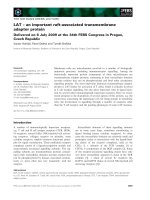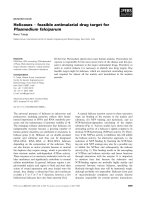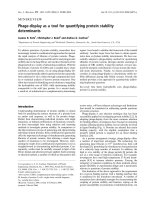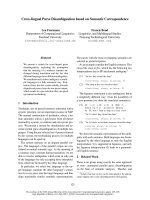Tài liệu Báo cáo khoa học: Helicases ) feasible antimalarial drug target for Plasmodium falciparum pptx
Bạn đang xem bản rút gọn của tài liệu. Xem và tải ngay bản đầy đủ của tài liệu tại đây (628.65 KB, 6 trang )
MINIREVIEW
Helicases
)
feasible antimalarial drug target for
Plasmodium falciparum
Renu Tuteja
Malaria Group, International Centre for Genetic Engineering and Biotechnology, New Delhi, India
The universal presence of helicases in eukaryotes and
prokaryotes, including parasites, reflects their funda-
mental importance in DNA and RNA metabolic pro-
cesses and the maintenance of genomic stability [1–4].
The emerging evidence demonstrates that helicases are
indispensable enzymes because a growing number of
human genetic disorders are attributed to mutations in
helicase genes [1–4]. Helicases act on double-stranded
nucleic acid substrate and thus can be designated
DNA–DNA, RNA–DNA or RNA–RNA helicases
depending on the composition of the substrate. They
are also known as motor proteins because to unwind
the duplexes they require energy, which is provided by
their intrinsic nucleic acid-dependent ATPase activity.
These enzymes act as necessary molecular tools for cel-
lular machinery and significantly contribute to normal
cellular metabolism. In general, helicases require a sin-
gle-stranded nucleic acid region to bind and start their
action of strand separation and once loaded onto the
strand, they display a directional bias and translocate
in either a 3¢ to 5¢ or 5¢ to 3¢ direction, however, a few
bidirectional helicases have also been reported [5,6].
A typical helicase reaction occurs in three successive
steps: (a) binding of the enzyme to the nucleic acid
substrate, (b) NTP binding and hydrolysis, and (c)
NTP-hydrolysis-dependent unwinding of the duplex
substrate (Fig. 1). Various studies have shown that the
unwinding activity of a helicase is tightly coupled to its
intrinsic NTP-hydrolyzing (NTPase) activity [7]. There-
fore, if the NTPase activity is inhibited, this will inhibit
the helicase activity. An alternative approach, i.e. the
reduction of NTP binding by blocking the NTP-bind-
ing site with NTP analogs may also be a possible way
to inhibit the NTPase and subsequently the helicase
activity (Fig. 1). This binding results in the uncoupling
of NTPase and helicase activities and hence functions
through interaction with the enzyme. It is important
to mention here that because the substrate- and
NTP-binding regions are probably highly similar and
conserved between various helicases, specifying the
blockade through these sites will be immensely tough,
although probably not impossible. Helicases form part
of macromolecular complexes and contain discrete
domains responsible for protein–protein interactions,
Keywords
DEAD-box; DNA unwinding; DNA-dependent
ATPase; DNA-interacting compounds; drug
target; helicase; inhibitors; malaria parasite;
molecular motor; Plasmodium falciparum
Correspondence
R. Tuteja, Malaria Group, International
Centre for Genetic Engineering and
Biotechnology, Aruna Asaf Ali Marg,
New Delhi-110067, India
Fax: +91 11 2674 2316
Tel: +91 11 2674 1358
E-mail:
(Received 23 April 2007, revised 23 May
2007, accepted 19 July 2007)
doi:10.1111/j.1742-4658.2007.06000.x
Of the four Plasmodium species that cause human malaria, Plasmodium fal-
ciparum is responsible for the most severe form of the disease and this par-
asite is developing resistance to the major antimalarial drugs. Therefore, in
order to control malaria it is necessary to identify new drug targets. One
feasible target might be helicases, which are important unwinding enzymes
and required for almost all the nucleic acid metabolism in the malaria
parasite.
FEBS Journal 274 (2007) 4699–4704 ª 2007 The Author Journal compilation ª 2007 FEBS 4699
therefore, in some cases strategies to block this inter-
action will also lead to inhibition of the activity.
Helicase signature motifs and
Plasmodium falciparum helicases
Based on sequence comparison and the presence of
characteristic ‘helicase motifs’, three helicase superfam-
ilies (SF1–3) have been identified [7–9]. SF1 and SF2
contain helicases that share a set of nine and SF3 con-
tains only a set of three highly conserved ‘helicase
motifs’, respectively [7–9]. The DEAD (Asp-Glu-Ala-
Asp), DEAH (Asp-Glu-Ala-His), DExH and DExD-
box helicases are ubiquitous and are the most common
members of SF2 [8,9]. The various ‘helicase motifs’
have been named Q, I, Ia, Ib, II, III, IV, V and VI
and, based on the mutational analysis and structural
data in a variety of systems, specific roles have been
suggested for a number of the conserved motifs [10–
12]. For example, motif I (A ⁄ GxxGxGKT), motif II
(VLDEAD), motif III (SAT) and motif VI
(HRIGRxxR) are responsible for ATP binding and
hydrolysis, nucleic acid binding and ATP-hydrolysis-
dependent nucleic acid unwinding, respectively [7]. It
has been reported that Arabidopsis thaliana contains
55 members of the DEAD-box family of helicases,
humans contain 38 and Saccharomyces cerevisiae con-
tains 25 [13]. In addition to the ‘helicase core region’,
which harbors the conserved motifs and functions as
an ATP-dependent motor or switch, most helicases
contain divergent amino and ⁄ or C-terminal extensions
that confer substrate specificity and provide the basis
for protein–protein interaction [14]. These structurally
different domains are also responsible for targeting the
helicase to a specific cellular process.
Although helicases have been reported from a vari-
ety of other systems there are very few reports of
helicases from P. falciparum. Since completion of the
P. falciparum genome in 2002, new opportunities for
research have arisen [15]. The P. falciparum genome
has 14 chromosomes, a linear mitochondrial genome
and a circular plastid-like genome [15,16]. A full set of
helicases was identified in the original genome
sequence of P. falciparum during annotation (http://
www.plasmodb.org), but detailed analysis using a
bioinformatic approach revealed that the genome con-
tains at least 22 full-length putative DEAD-box heli-
cases, as well as a few other putative helicases [15–18].
These 22 P. falciparum helicases contain all the con-
served domains, but the length and sequence of the
N- and C-terminal extensions and the intervening
sequences are variable [17]. Based on the crystal struc-
ture of human DEAD-box helicase, a model for the
structure of p68 (a well-characterized 68 kDa protein
of the DEAD-box protein family, which is conserved
from yeast to human) homolog of P. falciparum
(P. falciparum DNA helicase 60, PfDH60) was
created, which suggests that although there are minor
variations in length and sequence between the
conserved domains these two structures are highly
superimposable (Fig. 2). These observations further
suggest that although these proteins most likely act
through related mechanisms the parasite-specific
sequences could still be specifically targeted because
the antibodies to PfDH60 do not cross-react with the
human p68 [17,19–21].
To the best of our knowledge only a few helicases
have been characterized from P. falciparum. These
include two members of the DEAD-box family namely
PfDH60 and P. falciparum DNA helicase 45 (PfDH45)
[20,21] (A. Pradhan and R. Tuteja, unpublished) and
PfDHA, a 90 kDa DNA helicase which has been puri-
fied from P. falciparum [18]. Our studies indicated
that PfDH60 contains helicase and ssDNA-dependent
Fig. 1. Schematic representation of the three successive steps involved in a typical helicase reaction. The details of steps a–c are written
above the arrows. A particular helicase inhibitor ⁄ drug most probably acts at the substrate or enzyme level via one or more of the following
processes: (i) modulates enzyme–substrate binding, (ii) inhibits helicase activity by obstructing NTP binding, (iii) inhibits NTPase activity via
an undefined or allosteric mechanism, (iv) inhibits the coupling of NTP hydrolysis with the unwinding reaction, and (v) inhibits translocation
of the helicase on the nucleic acid substrate due to the steric blockade.
Helicases as an antimalarial drug target R. Tuteja
4700 FEBS Journal 274 (2007) 4699–4704 ª 2007 The Author Journal compilation ª 2007 FEBS
ATPase activities and is expressed in schizont stages of
the development of parasite [20,21]. It has also been
reported that PfDH60 is a unique dual, bipolar heli-
case and its enzyme activities are modulated by phos-
phorylation [21]. PfDH45 is a homolog of eukaryotic
initiation factor 4A contains helicase and ssDNA-
dependent ATPase activities and is expressed in all the
developmental stages of the parasite (A. Pradhan and
R. Tuteja, unpublished). PfDHA moves in the 3¢ to 5¢
direction and prefers a fork-like substrate for its
unwinding activity [18].
Helicases as drug and therapeutic
target
Resistance to the most efficient, reasonably priced and
safe antimalarials has called for the search for new
drug targets and ultimately new drugs. Because heli-
cases contain multiple functional domains and a vari-
ety of enzymatic activities, and have essential roles in
the metabolism of DNA and RNA, helicase inhibitors
might offer a feasible route towards the development
of novel drugs. Various studies have shown that heli-
cases are indispensable enzymes and in yeast the loss
of one DEAD-box gene cannot be supplemented by
overexpression of another family member, which fur-
ther suggests that each helicase gene is independently
essential [22,23]. Some helicases are required for the
proliferation of bacteria and viruses, therefore, inhibi-
tion of the unwinding activity of various helicases
results in a decrease in virus replication in cell cultures
as well as in animal models and this suggests a novel
antiviral strategy [24–27]. Potent antihelicase agents
have been reported for a number of helicases from dif-
ferent viruses [28]. The detailed characterization of two
related DEAD-box helicases, hepatitis C virus NS3
and human eIF-4A has provided evidence for design-
ing specific inhibitors that can be used to target the
viral NS3 helicase and inhibit the viral replication [5].
Table 1 shows a comparison of the inhibitory poten-
tial of some of the helicases from P. falciparum and
helicases from the human host. The comparison clearly
indicates that the IC
50
value for various compounds
tested, including daunorubicin and nogalamycin, is
lowest for helicases from P. falciparum compared with
the other helicases [29,30]. It is interesting to note that
inhibition by nogalamycin is highly variable and
depends on the source of the enzyme [31–34]. In a pre-
vious study it was reported that the IC
50
value for this
compound varied between 0.1 and >650 lm for heli-
cases from different viruses such as hepatitis C virus,
dengue fever virus, Japanese encephalitis virus and
west Nile virus [35,36]. It is possible that some of these
Fig. 2. Structural modeling of PfDH60. The protein sequence of
PfDH60 (GenBank accession number AY700082; PlasmoDB
No. PFL1310c) was subjected to the 3
D-JIGSAW program (version 2.0)
in . This server builds 3D models of proteins
based on known structural homologs [37–40]. The model for PfDH60
was built based on the solved crystal structure of human DEAD-box
helicase (Protein data bank Id:2I4I; Molecular Modeling Database
Id:41213) [39]. The conserved helicase motifs of both proteins are
displayed in different colors using a molecular visualization program
to display, animate and analyze large biomolecule systems using 3D
graphics and built-in scripting (
VMD software; -
c.edu). (A) Template structure, (B) PfDH60 structure. The colors
used for various motifs are: motif I, yellow; motif Ia, green; motif Ib,
red; motif II, light blue; motif III, white; motif VI, white.
R. Tuteja Helicases as an antimalarial drug target
FEBS Journal 274 (2007) 4699–4704 ª 2007 The Author Journal compilation ª 2007 FEBS 4701
compounds, which inhibit helicase activity, could be
utilized to inhibit parasite growth. In fact, it has been
shown that some of these compounds inhibited the
growth of P. falciparum in culture, which further con-
firms that inhibition of the activity of parasite helicase
inhibits the parasite growth [30].
Furthermore, these helicases can be specifically
targeted using the specific antibody and dsRNA
approach. Previous observations have shown that anti-
PfDH60 sera, which recognize only this protein in par-
asite lysate, inhibit parasite growth in culture [30].
Similar results were also obtained for anti-PfDH45
sera (A. Pradhan and R. Tuteja, unpublished).
Regarding the antisense approach, it has been shown
that the specific dsRNA against PfDH60 inhibited par-
asite growth in culture [30]. This inhibition is due to
the degradation of its cognate mRNA, which results in
inhibition of PfDH60 protein synthesis and in turn
inhibition of the parasite growth [30]. These results
collectively indicate that the helicases can be specifi-
cally targeted to inhibit their function. Although these
results are encouraging but overall the data on inhibi-
tor studies of malarial helicases are very limited.
Because helicases belong to a large gene family exten-
sive validation is required before the studies can focus
on a specific malarial helicase that could be used as a
specific target to control malaria. A comparative study
of available inhibitors may help to identify a com-
pound to specifically target and inhibit the parasite
helicase without affecting the host, and thereby could
be used as the potential drug ⁄ drugs to treat malaria.
Conclusions and future perspectives
Antimalarial drug resistance poses a major obstacle to
the control of malaria. Therefore, the development of
suitable and cost-effective drugs for the treatment of
malaria is a significant endeavor. Detailed studies
regarding the mechanism and function of all the
helicases of P. falciparum (including the DEAD-box
helicases) will help to establish their validity as a suitable
target. But extensive evaluation is essential before these
enzymes can be taken as bona fide targets for designing
therapies against malaria. The results summarized in
this article show a ray of hope to control malaria and
further studies should be carried out in this direction.
Acknowledgements
The author is grateful to Dr Narendra Tuteja, ICGEB,
New Delhi for critical comments on the manuscript
and Mr Arun Pradhan for help in preparation of
figures. The author also sincerely thanks the reviewers
for helpful comments. The work in authors’ laboratory
is supported by grants from Defence Research and
Development Organization and Department of Science
and Technology. Infrastructural support from the
Department of Biotechnology, Government of India is
gratefully acknowledged.
References
1 Matson SW, Bean DW & George JW (1994) DNA heli-
cases: enzymes with essential roles in all aspects of
DNA metabolism. Bioessays 16, 13–22.
2 Tuteja N & Tuteja R (1996) DNA helicases: the long
unwinding road. Nat Genet 13, 11–12.
3 Luking A, Stahl U & Schmidt U (1998) The protein
family of RNA helicases. Crit Rev Biochem Mol Biol 33,
259–296.
4 Sharma S, Doherty KM & Brosh RM (2006) Mecha-
nisms of RecQ helicases in pathways of DNA metabo-
lism and maintenance of genomic stability. Biochem J
398, 319–337.
5 Du MX, Johnson RB, Sun XL, Staschke KA, Colacino
J & Wang QM (2002) Comparative characterization of
two DEAD-box RNA helicases in superfamily II:
human translation-initiation factor 4A and hepatitis C
virus non-structural protein 3 (NS3) helicase. Biochem J
363, 147–155.
Table 1. Comparison of inhibitory potential of DNA-interacting compounds. ND, not determined.
Compounds PfDH45
a
PfDHA
b
PfDH60
c
PcDDH45
d
HDHII
e
WRN ⁄ BLM
f
Actinomycin 1.8 ND 0.8 > 50 11.7 100
Daunorubicin 1.5 2 0.3 7.5 6.2 ND
Ethidium bromide 1.0 ND 2.0 > 50 8.4 10
Mitoxantrone ND ND ND ND ND 10
Netropsin 0.5 ND 1.2 ND ND 10
Nogalamycin 0.5 5 1.5 1.7 0.42 ND
a
P. falciparum DNA helicase 45 (A. Pradhan and R. Tuteja, unpublished).
b
P. falciparum DNA helicase A (PfDHA) [18].
c
P. falciparum DNA
helicase 60 [30].
d
Plasmodium cynomolgi DEAD-box DNA helicase 45 [29].
e
Human DNA helicase II ⁄ Ku [40].
f
Werner (WRN) and Bloom
(BLM) DNA helicase [31].
Helicases as an antimalarial drug target R. Tuteja
4702 FEBS Journal 274 (2007) 4699–4704 ª 2007 The Author Journal compilation ª 2007 FEBS
6 Vashisht A, Pradhan A, Tuteja R & Tuteja N (2005)
Cold and salinity stress-induced pea bipolar pea DNA
helicase 47 is involved in protein synthesis and stimu-
lated by phosphorylation with protein kinase C. Plant J
44, 76–87.
7 Tuteja N & Tuteja R (2004) Unraveling DNA helicases.
Motif, structure, mechanism and function. Eur J Bio-
chem 271, 1849–1863.
8 Gorbalenya AE, Koonin EV, Donchenko AP & Blinov
VM (1989) Two related superfamilies of putative heli-
cases involved in replication, recombination, repair and
expression of DNA and RNA genomes. Nucleic Acids
Res 17, 4713–4730.
9 Linder P, Lasko PF, Ashburner M, Leroy P, Nielsen
PJ, Nishi K, Schnier J & Slonimski PP (1989) Birth of
the D-E-A-D box. Nature 337, 121–122.
10 Hodgman TC (1988) A new superfamily of replicative
proteins. Nature (London) 333, 22–23.
11 Gorbalenya AE & Koonin EV (1993) Helicases: amino
acid sequence comparisons and structure-function rela-
tionship. Curr Opin Struc Biol 3, 419–429.
12 Tanner NK (2003) The newly identified Q motif of
DEAD box helicases is involved in adenine recognition.
Cell Cycle 2, 18–19.
13 Rocak S & Linder P (2004) DEAD-box proteins: the
driving forces behind RNA metabolism. Nat Rev Mol
Cell Biol 5, 232–241.
14 Singleton MR & Wigley DB (2002) Modularity and spe-
cialization in superfamily 1 and 2 helicases. J Bacteriol
184, 1819–1826.
15 Gardner MJ, Hall N, Fung E, White O, Berriman M,
Hyman RW, Carlton JM, Pain A, Nelson KE, Bow-
man S et al. (2002) Genome sequence of the human
malaria parasite Plasmodium falciparum. Nature 419,
498–511.
16 Seow F, Sato S, Janssen CS, Riehle MO, Mukhopadhyay
A, Phillips RS, Wilson RJ & Barrett MP (2005) The plas-
tidic DNA replication enzyme complex of Plasmodium
falciparum. Mol Biochem Parasitol 141, 145–153.
17 Tuteja R & Pradhan A (2006) Unraveling the ‘DEAD-
box’ helicases of Plasmodium falciparum. Gene 376,
1–12.
18 Suntornthiticharoen P, Petmitr S & Chavalitshewink-
oon-Petmitr P (2006) Purification and characterization
of a novel 3¢)5¢ DNA helicase from Plasmodium falcipa-
rum and its sensitivity to anthracycline antibiotics. Para-
sitology 133, 389–398.
19 Caruthers JM, Johnson ER & McKay DB (2000) Crys-
tal structure of yeast initiation factor 4A, a DEAD-
box RNA helicase. Proc Natl Acad Sci USA 97,
13080–13085.
20 Pradhan A, Chauhan VS & Tuteja R (2005) A novel
‘DEAD-box’ DNA helicase from Plasmodium falcipa-
rum is homologous to p68. Mol Biochem Parasitol 140
,
55–60.
21 Pradhan A, Chauhan VS & Tuteja R (2005) Plasmo-
dium falciparum DNA helicase 60 is a schizont stage
specific, bipolar and dual helicase stimulated by PKC
phosphorylation. Mol Biochem Parasitol 144, 133–141.
22 Kessler MM, Henry MF, Shen E, Zhao J, Gross S, Sil-
ver PA & Moore CL (1997) Hrp1, a sequence-specific
RNA-binding protein that shuttles between the nucleus
and the cytoplasm, is required for mRNA-3¢-end forma-
tion in yeast. Genes Dev 11, 2545–2556.
23 Linder P, Gasteiger E & Bairoch A (2000) A comprehen-
sive web resource on RNA helicases from the baker’s
yeast Saccharomyces cerevisiae. Yeast 16, 507–509.
24 Borowski P, Lang M, Haag A, Schmitz H, Choe J,
Chen HM & Hosmane RS (2002) Characterization of
imidazo[4,5-d]pyridazine nucleosides as modulators of
unwinding reaction mediated by West Nile virus nucleo-
side triphosphatase ⁄ helicase: evidence for activity on the
level of substrate and ⁄ or enzyme. Antimicrob Agents
Chemother 46, 1231–1239.
25 Kleymann G (2003) New antiviral drugs that target her-
pesvirus helicase primase enzymes. Herpes 10, 46–52.
26 Kwong AD, Rao BG & Jeang KT (2005) Viral and cel-
lular RNA helicases as antiviral targets. Nat Rev Drug
Discov 4, 845–853.
27 Frick DN (2003) Helicases as antiviral drug targets.
Drug News Persp 16, 355–362.
28 Frick DN & Lam AM (2006) Understanding helicases
as a means of virus control. Curr Pharm Des 12,
1315–1338.
29 Tuteja R, Tuteja N, Malhotra P & Chauhan Singh V
(2003) Replication fork-stimulated eIF-4A from Plasmo-
dium cynomolgi unwinds DNA in the 3¢ to 5¢ direction
and is inhibited by DNA-interacting compounds. Arch
Biochem Biophys 414, 108–114.
30 Pradhan A & Tuteja R (2006) Plasmodium falciparum
DNA helicase 60:ds RNA and antibody-mediated inhi-
bition of malaria parasite growth and downregulation
of its enzyme activities by DNA-interacting compounds.
FEBS J 273, 3545–3556.
31 Brosh RM Jr, Karow JK, White EJ, Shaw ND, Hick-
son ID & Bohr VA (2000) Potent inhibition of Werner
and bloom helicases by DNA minor groove binding
drugs. Nucleic Acids Res 28, 2420–2430.
32 Pham XH & Tuteja N (2002) Potent inhibition of DNA
unwinding and ATPase activities of pea DNA helicase
45 by DNA-binding agents. Biochem Biophys Res Comm
294, 334–339.
33 Bachur NR, Yu F, Johnson R, Hickey R, Wu Y &
Malkas L (1992) Helicase inhibition by anthracycline
anticancer agents. Mol Pharmacol 41, 993–998.
34 Egli M, Williams LD, Frederick CA & Rich A (1991)
DNA–nogalamycin interactions. Biochemistry 30,
1364–1372.
35 Borowski P, Niebuhr A, Schmitz H, Hosmane RS,
Bretner M, Siwecka MA & Kulikowski T (2002)
R. Tuteja Helicases as an antimalarial drug target
FEBS Journal 274 (2007) 4699–4704 ª 2007 The Author Journal compilation ª 2007 FEBS 4703
NTPase ⁄ helicase of Flaviviridae: inhibitors and inhibi-
tion of the enzyme. Acta Biochim Pol 49, 597–614.
36 Dubaele S, Jahnke W, Schoepfer J, Fuchs J & Chene P
(2006) Inhibition of DNA helicases with DNA-competi-
tive inhibitors. Bioorg Med Chem Lett 16, 923–927
[Epub 21 November 2005].
37 Bates PA, Kelley LA, MacCallum RM & Sternberg
MJE (2001) Enhancement of protein modelling by
human intervention in applying the automatic programs
3D-JIGSAW and 3D-PSSM. Protein Struct Funct Genet
5 (Suppl.), 39–46.
38 Bates PA & Sternberg MJE (1999) Model building by
comparison at CASP3: using expert knowledge and
computer automation. Protein Struct Funct Genet 3
(Suppl.), 47–54.
39 Contreras-Moreira B & Bates PA (2002) Domain
fishing: a first step in protein comparative modeling.
Bioinformatics 18, 1141–1142.
40 Chen J, Anderson JB, DeWeese-Scott C, Fedorova ND,
Geer LY, He S, Hurwitz DI, Jackson JD, Jacobs AR,
Lanczycki CJ et al. (2003) MMDB: Entrez’s 3D-struc-
ture database. Nucleic Acids Res 31, 474–477.
41 Tuteja N, Phan TN, Tuteja R, Ochem A & Falaschi A
(1997) Inhibition of DNA unwinding and ATPase activ-
ities of human DNA helicase II by chemotherapeutic
agents. Biochem Biophys Res Commun 236, 636–640.
Helicases as an antimalarial drug target R. Tuteja
4704 FEBS Journal 274 (2007) 4699–4704 ª 2007 The Author Journal compilation ª 2007 FEBS









